Balsall Heath is an inner-city area of Birmingham, West Midlands, England. It has a diverse cultural mix of people and is the location of the Balti Triangle.
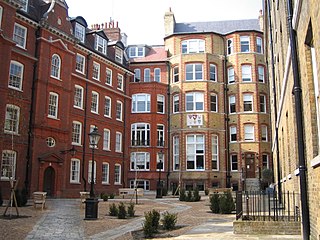
The Honourable Society of the Inner Temple, commonly known as the Inner Temple, is one of the four Inns of Court in London. To be called to the Bar and practise as a barrister in England and Wales, a person must belong to one of these Inns. It is located in the wider Temple area of the capital, near the Royal Courts of Justice, and within the City of London.
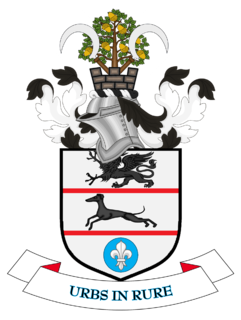
The Metropolitan Borough of Solihull is a metropolitan borough in West Midlands county, England. It is named after its largest town, Solihull, from which Solihull Metropolitan Borough Council is based. It is sometimes locally nicknamed "Solihullshire". For Eurostat purposes it is a NUTS 3 region and is one of seven boroughs or unitary districts that comprise the "West Midlands" NUTS 2 region. Much of the large residential population in the north of the borough centres on the communities of Castle Bromwich, Chelmsley Wood, Fordbridge, Kingshurst, Marston Green and Smith's Wood. In the south are the borough town of Solihull and its sub-town Shirley as well as the large villages of Knowle, Dorridge, Meriden and Balsall Common.

Penn is an area now divided between the City of Wolverhampton and South Staffordshire district. The population of the Wolverhampton Ward taken at the 2011 census was 12,718. Originally, it was a village in the historic county of Staffordshire. There is considerable confusion about exactly which areas fall within Penn. In 19th century censuses, Merry Hill, Bradmore are understood to form part of Penn, although these areas are generally understood to be separate today. However, there has never been any doubt that the two historic settlements of Upper and Lower Penn form the core of the area.

Lilleshall is a village and civil parish in the county of Shropshire, England.

George Granville Sutherland-Leveson-Gower, 2nd Duke of Sutherland, KG, styled Viscount Trentham until 1803, Earl Gower between 1803 and 1833 and Marquess of Stafford in 1833, was a British Whig MP and peer from the Leveson-Gower family.
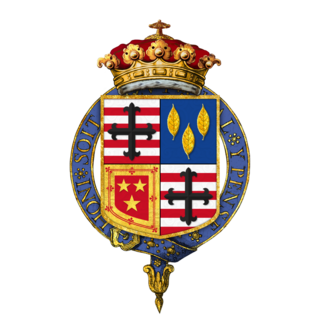
Cromartie Sutherland-Leveson-Gower, 4th Duke of Sutherland,, styled Lord Cromartie Sutherland-Leveson-Gower until 1858, Earl Gower between 1858 and 1861 and Marquess of Stafford between 1861 and 1892, was a British peer and politician from the Leveson-Gower family.

Balsall Preceptory in Warwickshire was a manor that was given to the Knights Templars in recognition of their service in the Crusades. The donor, according to a survey of the Templars' possessions in England in 1185, was Roger de Mowbray, son of Nigel d'Aubigny.

Tregony, sometimes in the past Tregoney, is a village and former civil parish, now in the parish of Tregony with Cuby, in Cornwall, England, United Kingdom. It lies on the River Fal. In the village there is a post office, shop, a sports and social club and two churches. Tregony has bus links to the nearest city, Truro. Cornelly parish was united with Tregony in 1934. On 1 April 2021 the parish was abolished and merged with Cuby to form "Tregony with Cuby". Tregony was once a port, but clay mining upriver in St Austell has caused the river to become silted over. The population was 768 in 2011 with nearly 15% claiming Cornish identity.

South Hackney is an area of Hackney in London, England within the Borough of Hackney. It is about 4.2 miles (6.8 km) northeast of Charing Cross.

Berkswell is a village and civil parish in the Metropolitan Borough of Solihull, county of West Midlands, England. Historically in Warwickshire, Berkswell is situated in the rural east of the borough, approximately 2 miles (3.25 km) west of the western city boundary of Coventry, at Eastern Green. It is situated about 6.5 miles (10 km) west of Coventry city centre, 8.5 miles (13.5 km) east of central Solihull, 2.5 miles (4 km) south of Meriden and 2 miles (3.25 km) north of Balsall Common.

Lilleshall Hall is a large former country house and estate in the fields of Lilleshall, Shropshire, England.
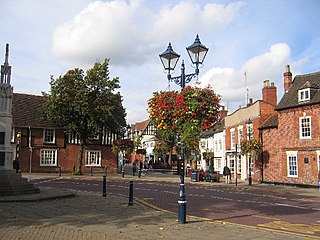
Solihull is a large, historic market town in the south of the West Midlands, England, with a population of 123,187 at the 2011 Census. Historically in Warwickshire, Solihull is situated on the River Blythe in the Forest of Arden area, south of the centre of England. It is the largest town in, and seat of, the Metropolitan Borough of Solihull, which has a population of 214,909. Solihull is the most affluent town in the West Midlands region, and one of the most affluent areas in the UK outside London. The town is largely rural, with three quarters of the borough designated green belt. The town has roots dating back to the 1st century BC, and was further formally established during the Anglo Saxon and Norman eras of British history. Today the town is famed as, amongst other things, the home of the Land Rover car marque, and the British equestrian eventing team.
Faxton is an abandoned village and chapelry in the county of Northamptonshire in England. Nearby are the villages of Old, Lamport and Mawsley and the Northampton & Lamport Railway.

Hardwick House was a manor house near Bury St Edmunds, Suffolk, owned by Sir Robert Drury, Speaker of the House of Commons, of Hawstead Place. It was subsequently purchased in the seventeenth century by Royalist Robert Cullum, a former Sheriff of London. Experts in Suffolk county history as well as noted authorities in antiquarian and botanical matters, the Cullum family of eight successive baronets authored works on the county and its fauna and flora. Sir Thomas Gery Cullum, a Charterhouse graduate, medical doctor and member of the Royal Academy and the Linnean Society, was a well-regarded author on science and botany.
The Honourable Granville Dudley Ryder JP, was a British Tory politician.
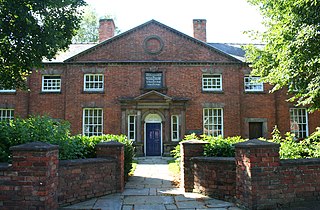
Crewe Almshouses or Crewe's Almshouses is a terrace of seven former almshouses at the end of Beam Street in Nantwich, Cheshire, England. The present building was erected in 1767 by John Crewe, later first Baron Crewe, and is listed at grade II. It has a central projecting section topped by a pediment, with a stone doorway flanked with Tuscan columns. The present almshouses stand on the site of a 16th-century building, originally the mansion of the Mainwaring family and later the town's House of Correction and workhouse.
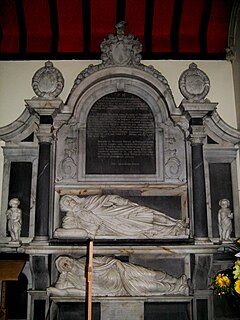
Sir Richard Leveson (1598–1661) was an English politician who sat in the House of Commons from 1640 to 1642. He supported the Royalist cause during the English Civil War.

Sir Richard Leveson was an important Elizabethan Navy officer, politician and landowner. His origins were in the landed gentry of Shropshire and Staffordshire. A client and son-in-law of Charles Howard, 1st Earl of Nottingham, he became Vice-Admiral under him. He served twice as MP for Shropshire in the English parliament. He was ruined by the burden of debt built up by his father.
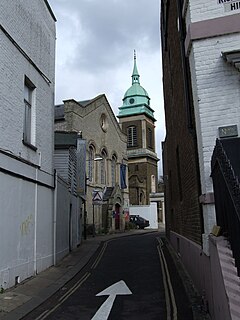
The Vineyard is a street in Richmond, in the London Borough of Richmond upon Thames. It includes three groups of almshouses, a Grade II listed church and Clarence House, a 17th-century Grade II listed house associated with Bernardo O’Higgins, who is commemorated on the wall of the property with a blue plaque, installed by English Heritage, for his role in the Chilean War of Independence.

















